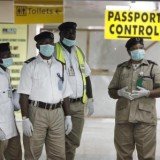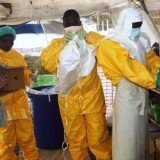Coronavirus Confirmed Cases Passes One Million Mark Worldwide
As the world struggles to get a grip on the virus to slow the curve, infections are expected to surpass one million with the death toll at 50,000. Rather than flattening the curve, there’s been a spike in infection rates as more countries increase their testing capacity. The WHO boss, Tedros Adhanom Ghebreyesus, has voiced his “deep concerns” of the rapid spread and rise of infection across the world. It’s been more than three months since China first alerted the world of the new Coronavirus. Countries all over the world are taking measures to help the vulnerable people in a bid to ensure they stay at home. In the US, the death toll has surpassed five thousand while the infected exceeds two hundred thousand.

A view of the deserted central business district is pictured on the first day of a 14-day lockdown aimed at limiting the spread of coronavirus disease (COVID-19) in Lagos, Nigeria March 31, 2020. REUTERS/Temilade Adelaja – RC22VF961ZXM
It is not all doom and gloom though as over one hundred and fifteen thousand people have recovered from the virus. Despite the spike in infection the virus has reasonably mild symptoms. For many people, an infection will feel as though they were suffering from the common cold. Despite the fact the infection rate of the virus dwarfs MERS and SARS, it has also shown to be less fatalistic. For most young people, a COVID-19 infection isn’t a death sentence. However, for the old and immunocompromised, the disease can be fatal.
Ventilators
There’s been a scramble across the world to build ventilators as the infection rate rushes towards the one million mark. But what are ventilators? A ventilator is a machine that assists the body to breath when the lungs fail due to disease. For most patients who require hospitalization, ventilators are their best chance of beating the virus. A ventilator works by pushing air into the lungs. The Coronavirus attacks the lungs and the body reacts by causing blood vessels to expand. However, this also allows fluid into the lungs thereby making it difficult to breathe. The humidifier attached to the ventilator also allows in heat and moisture to synch with the body temperature of the patient. Many countries are placing orders for ventilators with the UK putting in for 10,000 machines from Dyson. Countries like Nigeria have less than 500 ventilators in the entire country.
Vaccine
While there’s no vaccine yet, scientists in Australia have begun animal testing of potential vaccines. The vaccines are a result of a partnership between Inovio Pharmaceutical company and Oxford University. The national science agency in Australia will decide whether the vaccines are effective, safe treatment for humans. Apart from the Aussies spearheading the search for a vaccine, there are many other. Companies and institutions working on a vaccine across the world.
Available treatment
A drug that holds the potential to treat Coronavirus is being trialled on select patients across the UK. Manufactured by Gilead, a pharmaceutical company, Remdesivir is one of a few drugs that is being tested on patients with mild and serious symptoms. The US is also trying out a treatment that involves the use of Chloroquine and Azythromycine.
So what is the way forward? Until a vaccine or cure is found, follow the steps below:
- Stay home as often as possible
- Maintain social distancing
- Wash your hands with soap regularly or use a hand sanitizer
- Sneeze inside your elbow. If you cough into a material, dispose properly.
- If you’re displaying signs of the disease, call your health care provider at once.
From the Bubonic Plague in the 14th century to COVID-19, pandemics are bound to happen. It’s up to mankind to be prepared and stay ready.


















